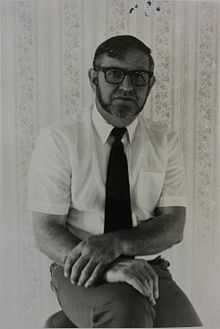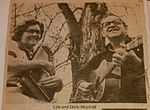Herbert Lyle Mayfield
| Herbert Lyle Mayfield | |
|---|---|
 Lyle Mayfield, September 1980. | |
| Background information | |
| Born |
March 4, 1929 Greenville, Illinois |
| Died |
March 31, 2012 (aged 83) St. Louis, Missouri |
| Genres | traditional folk, traditional country, gospel, swing |
| Occupation(s) | musician, singer-songwriter, inventor, writer, printer, poet |
| Years active | 1935–2012 |
| Labels | self-produced |
| Website | http://mayfieldmusiccompany.com |
| Notable instruments | |
| guitalin, guinjo, friddle, triplin | |
 |
"Green Fields of Illinois"
The Mayfield Family theme song |
| Problems playing this file? See media help. | |
Herbert Lyle Mayfield, known generally as Lyle, (March 4, 1929 – March 31, 2012) was an American writer, poet, printer, inventor of musical instruments, and folk musician and composer from Greenville, Illinois. He spent most of his adult life working in the printing trade as a profession, but spent most of his spare time designing and building hybrid folk instruments and performing at live music events with his wife Doris (Mindrup) Mayfield and youngest son, Layne Mayfield. Lyle is notable for his invention of both the guitalin and guinjo, hybrid folk instruments combining features of several traditional folk instruments.
Early Life and Family
The Mayfield family music story began in the mid-1930s when Lyle’s mother purchased him a 25-cent harmonica. She turned to the seven-year-old and said, "Learn to play it, son. I like French harp music." Next came the acquisition of a six-dollar, used guitar. The friend he bought it from showed Lyle three chords. Eight months later the friend’s band had a new guitar player.
In 1950, Lyle Mayfield married Doris Mindrup, and less than a year later the couple were doing their own radio show on WSMI in Litchfield, Illinois, as the "Bond County Sweethearts." The title changed to "The Mayfield Family" as their children (oldest to youngest) David, Lynda and Layne came on the scene. David made his debut on the show at the age of three months. He lay in an empty guitar case in the studio while Mom and Pop crooned. One day he decided to add a little harmony of his own. Lyle apologized to the listeners for the unexpected voice in the background. A listener wrote in saying, "Don’t apologize. It’s the best music on your show."
Musical Performance Career

Throughout the latter half of the 20th century, the Mayfields appeared to perform at hundreds of festivals, picnics, shows, church activities, benefits, square dances and ordinary jam sessions. Some of the highlights include bookings at the Olde Towne School of Folk Music in Chicago, The First Annual Arkansas Folk Festival, The Lincoln Jamboree in Kentucky, Illinois State Fair, The 1976 Bi-Centennial Smithsonian Folklife Festival held in Washington, DC and various other functions from Kansas City to Grand Rapids to St. Louis to Indianapolis to Battle Ground, Indiana.
Starting with their first 45rpm single in 1964, the Mayfields recorded two singles, one LP and more than 40 self-produced cassette albums. They have also contributed to several other albums for various folk music groups around the country. In 1964, they cut five bands on an album of folk music produced by the Campus Folksong Club at the University of Illinois. It was entitled "Green Fields of Illinois." From this Lyle came up with the inspiration for the song "Green Fields of Illinois", which a local state senator briefly worked and failed to get accepted as the state song of Illinois. It became the duo's theme song and is the title song of their LP album "Green Fields Re-Visited."
From a repertoire of songs and influences numbering in the thousands, the Mayfields brought a family-oriented program ranging from folksongs to popular tunes of the 1930s and 1940s to classic country to down home gospel. They supplemented this with many of their own original compositions. They owned and played a variety of instruments, several of which Lyle designed and built himself. Among these inventions were the guitalin and guinjo. Upon Lyle's death, there were more than 100 instruments counted in the Mayfield home.
Lyle worked as a journeyman printer for many newspapers in Southern Illinois, including The Greenville Advocate for many years. He was a columnist for the Advocate with his column entitled "Thoughts In Passing", which ran in the paper for several years. In 1949 he helped establish the Explorer Scouts in Greenville, Illinois, and in 1950 was a founding member of Boy Scout Troop 50 in Greenville.
In the 1960s, Lyle and Doris Mayfield were involved in the University of Illinois at Urbana-Champaign Campus Folksong Club and were associated with Archie Green during that time.[1] In the mid-1960s, Lyle was credited for bringing the native music of Illinois to the Campus Folksong Club and appeared on recordings that the club produced, including the "Green Fields of Illinois" record.[2][3][4][5] He and Doris regularly appeared in performances held by the Folksong Club, commonly referred to as "folk sings".[6][7][8] They also volunteered their time and talents to perform for other events and venues.[9] In 1976, Lyle and Doris Mayfield, along with their son Layne, were invited by the Smithsonian Institution to represent Southern Illinois at the American Bicentennial Smithsonian Folklife Festival.[10][11][12] It was at this event that they had a good opportunity to showcase some of their unique folk instruments; namely the guitalin and guinjo. Throughout most of the 1970s, the Mayfields devoted much time to preserving traditional southern Illinois music and folklore. Additionally, they were the founders and principle sponsors of the annual Southern Illinois Folk Convention in the early 1970s.[13]

 |
The Guitalin - 1976 Bicentennial Smithsonian Folklife Festival
Lyle Mayfield demonstrating the guitalin, onstage in Washington, DC, 1976. |
| Problems playing this file? See media help. | |
Later life and death
Lyle stated over a phone interview with the host of "Living in Illinois" (a radio show based in Springfield, Illinois) that "in the mid-1920s, three 50,000-watt radio stations created a triangular area and bombarded it with live music, introducing musical sounds from around the United States and the world. Those who lived in that golden triangle of sound absorbed it all. I can't say with any degree of certainty how this affected aspiring musicians in other areas, but in my neck of the woods musicians digested it all, and what we absorbed filtered into our own musical creativity."
Through his ongoing musical career, Lyle cited Eddy Arnold as one of the strongest influences in the urban audiences of acceptance of "hillbilly music", renaming it, more politely, "Traditional Country". As recordings obtained more quality and availability, the era from the 1930s to the 1960s covered the region of Southern Illinois with a thick blanket of melodies and lyrics.
While the Mayfields tried not to restrict themselves from listening to any one brand of music, they took issue with mutations of their dearly-held musical terminology. Lyle scoffed at Bob Dylan being held as a folk songwriter, saying, "you don't write a popular folk song. That music evolved; it tells a story." Lyle said that some of Dylan's music may become folk if it lasts a few generations. He disliked new country, saying there was "no such thing". He also didn't like hard rock and was adamant that rap had "nothing to do with music". Bluegrass to Lyle was a "Johnny-come-lately" to his part of the country and he seemed to only enjoy it in its pure form.
Throughout their region, Lyle and Doris Mayfield were known for helping to keep the history of music alive by "vivid recall and recitation". Lyle died from complications with a Bilateral Watershed Stroke on March 31, 2012 after being in a coma-like state for 2 to 3 days.
Notable Works of Literature
- "The Old Trees Die the Hardest" (selected entries from Lyle's column "Thoughts in Passing", from the pages of The Greenville, Illinois, Advocate)
- "The Ballad of Melissa" - a story based on an old folk legend from the turn-of-the-century in Southern Illinois about a girl who was found frozen in the snow, seven miles from her home.
- "Through A Broken Window Pane" - A poetic collection of thoughts composed by Lyle from 1947 through 2006.
References and notes
- ↑ Daily Illini (University of Illinois), Friday, September 20, 1963, p. 9
- ↑ Introduction to the Campus Folksong Club, University of Illinois at Urbana-Champaign
- ↑ Daily Illini (University of Illinois), Friday, November 19, 1965, p. 4
- ↑ Daily Illini (University of Illinois), Saturday, February 22, 1964, p. 7
- ↑ Daily Illini (University of Illinois), Wednesday, February 19, 1964, p. 4
- ↑ Daily Illini (University of Illinois), Friday, November 09, 1962, p. 11 http://idnc.library.illinois.edu/cgi-bin/illinois?a=d&d=DIL19621109.2.48&dliv=none&e=-------en-20--1--txt-txIN-------].
- ↑ Daily Illini (University of Illinois), Saturday, February 22, 1964, p. 1
- ↑ Daily Illini (University of Illinois), Friday, October 4, 1963, p. 3
- ↑ The Greenville Advocate, Thursday, August 31, 1972
- ↑ The Greenville Advocate, Friday, June 18, 1976, JPEG Image
- ↑ The Illinois State Journal, June 29, 1980, JPEG Image
- ↑ The Greenville Advocate, August 21, 1980, p. 15
- ↑ The Greenville Advocate, Thursday, March 23, 1972